Excerpts from Jim Conrad's
Naturalist Newsletter
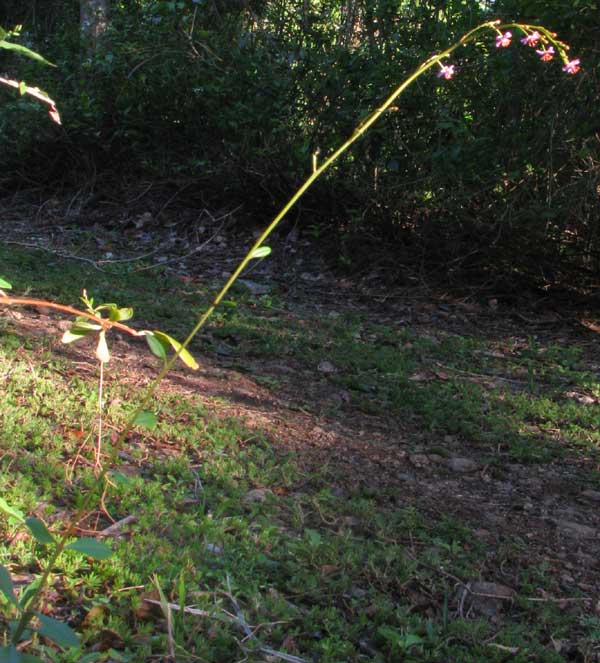
from the March 20, 2011 Newsletter issued from Hacienda Chichen Resort beside Chichén Itzá Ruins, central Yucatán, MÉXICO; limestone bedrock, elevation ~39m (~128ft), ~N18.52°, ~W95.15°
TALINUM'S PINK, TINY FLOWERS
Especially along shadowy forest trails you notice knee-high, slender stems arching over the path, bearing a few tiny flowers that tend to be closed in the mornings but open in the afternoons -- something unusual for such delicate-looking flowers, which you'd expect to be morning-bloomers. The plant is shown above. A flower, its pink petals about 3/16-inch long (4 mm) is seen below:
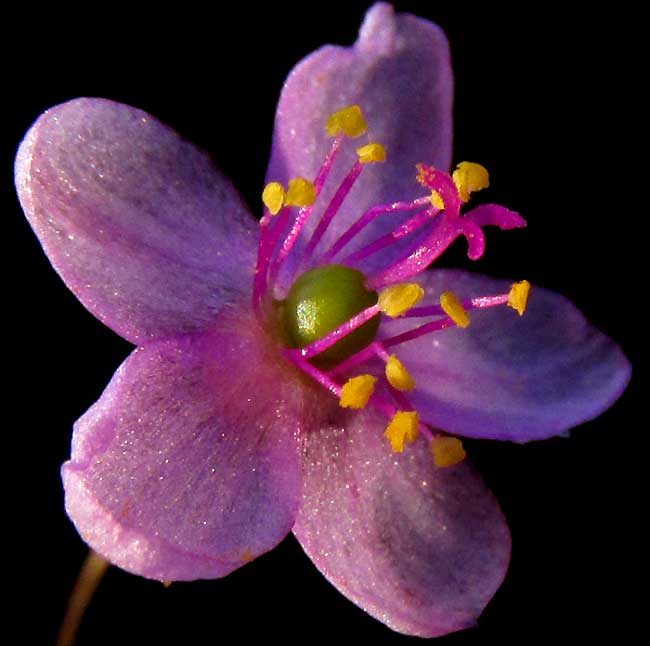
That flower is unexpectedly pretty in its simplicity. It's almost like the "Standard Blossom" I use to teach flower anatomy -- the most average, unspecialized flower imaginable. Note its five pink petals, its several stamens with their slender, pink filaments and yellow, pollen-packed anthers, and then the spherical, green ovary in the center, topped by a slender, pink, neck-like style three-parted at the top, each of the three parts bearing a rough, sticky stigmatic surface where pollen from other flowers is deposited and germinates.
Despite this plant's fragile appearance it's a robust species inhabiting a wide variety of habitats over a very large distribution area.It's native from the southern US states through Mexico and most of tropical America, plus it's been introduced into southern Africa and southern Asia. As such it goes by several English names, including Pink baby-breath and Jewels of Opar. Both of these names are so fanciful that I prefer just the genus name, Talinum. It's TALINUM PANICULATUM, a member of the Portulaca or Purslane Family, a family whose flowers often are especially bright and pretty.
Standley reports that the leaves of this species make a good substitute for spinach. The leaves of our plants are so small and tough that not many folks nowadays would want to eat them, but maybe the time will come when people again will be happy for a pot of Talinum greens.
from the January 11, 2019 Newsletter issued from Rancho Regensis north of Valladolid, Yucatán, MÉXICO;
elevation ~40m (~130 ft), N~20.876°, W~88.170°
JUAN'S TOOTHACHE
This week the Maya worker Juan came to work at the rancho with a swollen cheek onto which black tatters of something were sticking. He had a toothache and the black tatters were pieces of leaf of a medicinal herb he said relieved the pain. Of course I wanted to know which herb he'd used. He called it Hool-k'iim, which meant nothing to me. Always glad to indulge my curiosity about these things, Juan brought me a sprig of the plant. Below, you can see him, his swollen cheek and the herb whose black leaf-tatters are pasted to his face:
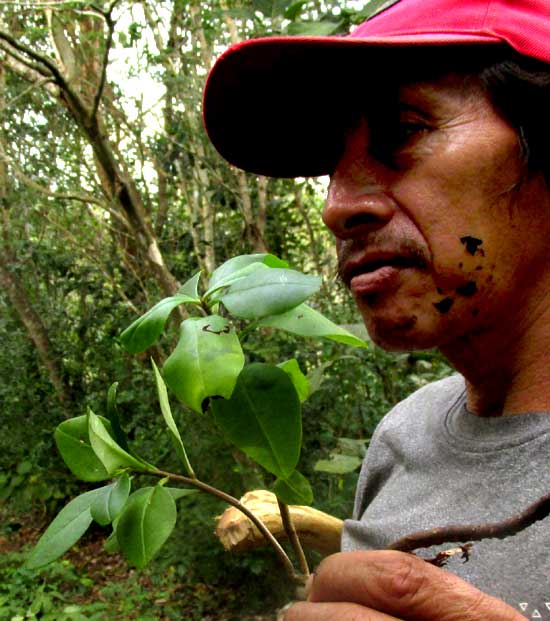
At first I couldn't identify the sprig, so Juan took me to where it grew, in a shaded spot beside the garden, shown below:
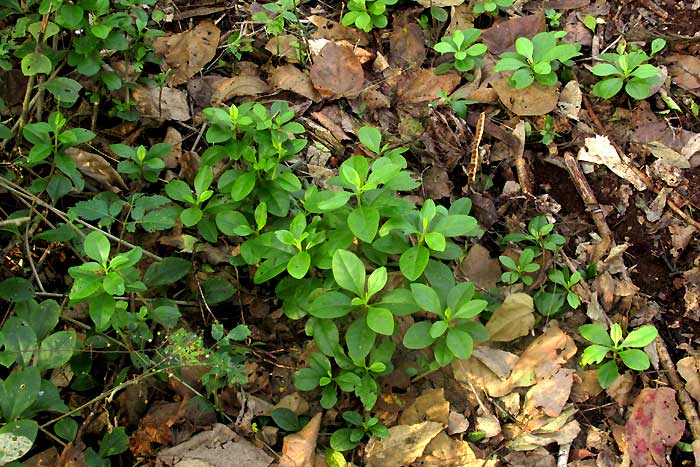
The moment I saw the spot I knew that we were dealing with Talinum paniculatum, a commonly occurring, fairly weedy species, and a member of the Purslane or Portulaca Family, the Portulacaceae. Earlier we've seen that the leaves are edible, but nothing was said about the plant's medicinal value. While at Juan's leaf-picking spot I picked a leaf myself and held it against the sun, to see if tiny bright spots showed up, spots often representing pockets of oil rich in chemicals that sometimes are medicinal. Below, you can see that many very tiny spots did appear:
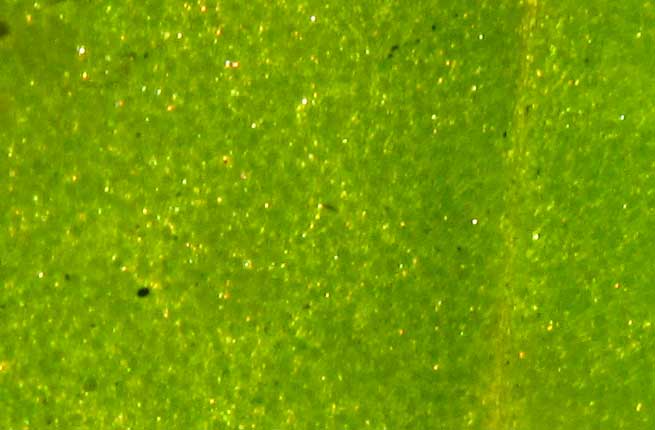
When I asked Juan how he prepared the black flakes stuck to his face from the green leaves, he explained that you simply crush the leaf with your fingers, and the soft leaf bruises and breaks apart, producing soggy pieces that can be stuck to the skin. I squeezed a leaf and got what's shown below:
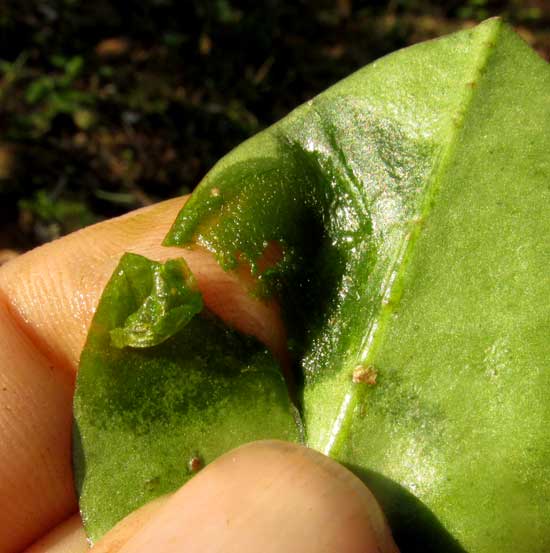
Pages on the Internet describe several traditional medicinal uses for the plant, though none mentioned its use for the toothache. One traditional use that seems to cross cultural boundaries is that of its serving as a "reproductive tonic", especially as an aphrodisiac.
There might be something to that claim. The single scientific study I could find on the species' medicinal value, Catthareeya Sukwan's "Talinum paniculatum (Jacq.) Gertn: A medicinal plant with potential estrogenic activity in ovariectomized rats," in the March, 2013 edition of International Journal of Pharmacy and Pharmaceutical Sciences, found that, in rats, extracts of roots and leaves produced "estrogenic activity... which can be helpful in managing reproductive tissues regression during menopause... "
Talinum paniculatum is native from across the southern US south through Mexico, the Caribbean and Central America, to South America. It's been introduced into southern Africa and southern Asia. Sometimes it's grown as an ornamental, and certain horticultural forms with white blotches or lines on the leaves have been developed.
from the January 18, 2019 Newsletter issued from Rancho Regensis north of Valladolid, Yucatán, MÉXICO;
elevation ~40m (~130 ft), N~20.876°, W~88.170°
JUAN'S TOOTHACHE, WEEK TWO
This week Juan got more serious about treating his pain by concocting a green paste made of three locally common herbs, and he was kind enough to let me document his various doings. His using three herbs instead of one sounds right to me because curanderos, or healers, I've known seldom relied on a single ingredient for their medicines. Their treatments usually consisted of three or more components.
First we went to the same place as before, to pick more Talinum paniculatum leaves. Then we walked just a few feet, to the other side of the shaded compost area, and picked a few leaves of Leaf-flower, Phyllanthus amarus, which we've profiled at www.backyardnature.net/yucatan/leafflwr.htm
Below, you can see Juan collecting his Leaf-flower leaves:
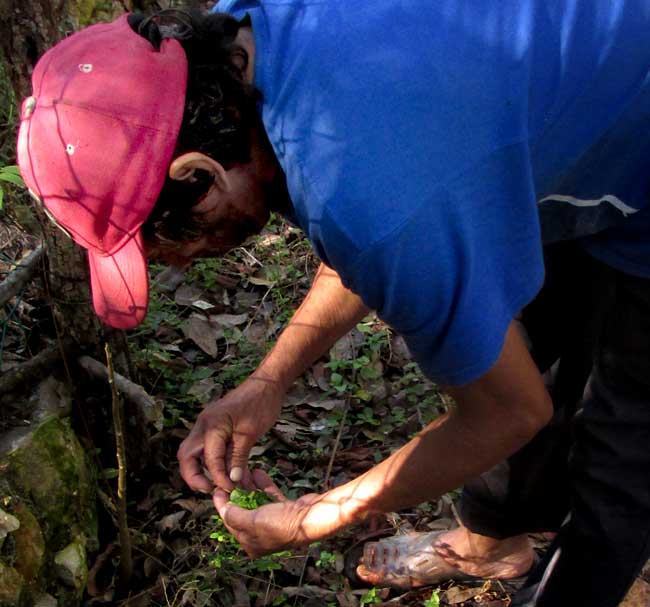
Notice that Juan isn't picking the whole plant, just removing leaves. The slender, wiry stem of Phyllanthus amarus is semi-woody, so Juan placed the stem between two fingers and raked upward, the leaves coming off individually. "Now the stem will grow new leaves," he said.
Next we gathered a few leaves of Square-stemmed Misteletoe, Phoradendron quadrangulare, parasitizing a nearby Bay Cedar, Guazuma ulmifolia. Our Square-stemmed Mistletoe page is at www.backyardnature.net/yucatan/mistlet3.htm
Below, you can see the entire collection of leaves from the three above species:
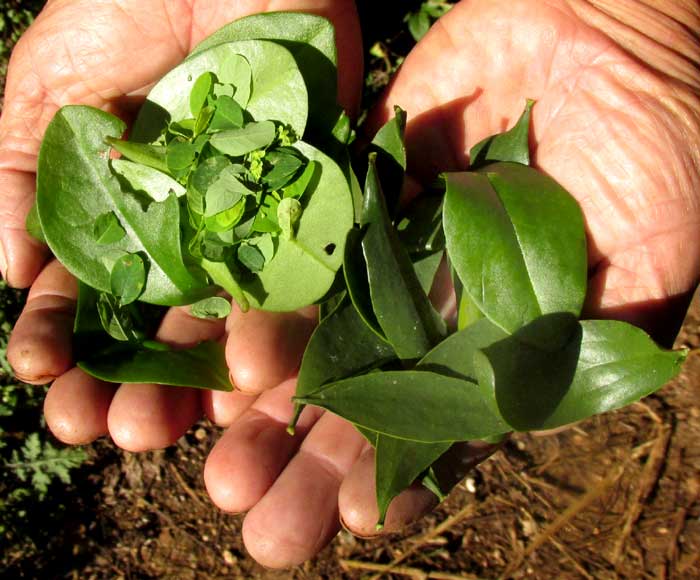
On the picture's left side, the larger leaves at the bottom are from Talinum paniculatum. Atop them lie the Leaf-flower's leaves, and on the right side of the picture you see the mistletoes's blades.
On our pages for the above plants we've already noted that these species are recognized widely as medicinal plants. Studies have shown that, in rats, extracts of roots and leaves of Talinum paniculatum produced "estrogenic activity... which can be helpful in managing reproductive tissues regression during menopause... " Extracts of the Square-stemmed Mistletoe affect "cytotoxicity, apoptosis, tumour inhibition, induction of immune processes and antioxidant activity." Leaf-flower is much used in India's Ayurvedic system of medicine for a long list of problems, including, gonorrhea and other genital afflictions, diarrhea, dysentery, intermittent fevers, ophthalmopathy, scabies, ulcers and general wounds."
Now it was time to mash the leaves into a green paste. Normally Juan uses as a grinding bowl, or morter, half of a gourd-like jícara fruit from what's sometimes called the Calabash Tree (Crescentia cujete. That interesting tree is profiled at www.backyardnature.net/yucatan/calabash.htm
However, Juan's jícara was filled with something else, so he used the bottom of a liter-size Coca-Cola plastic bottle, as shown below:
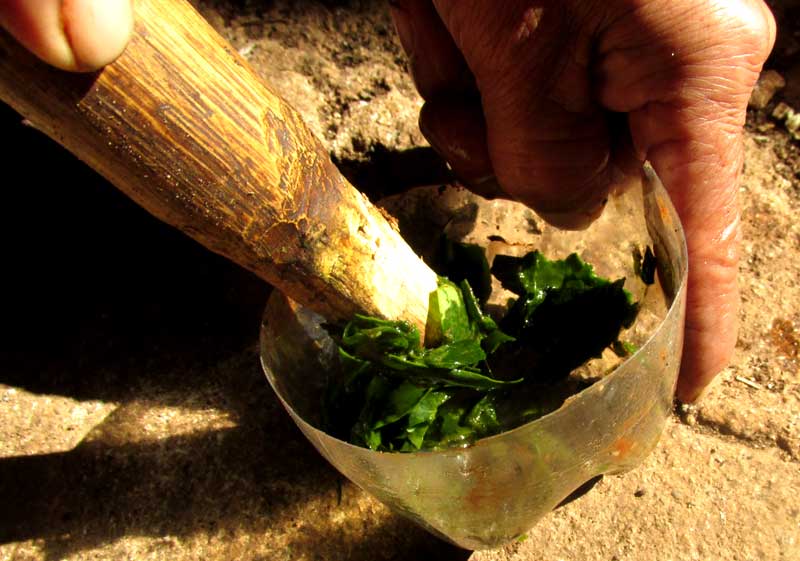
The grinder, or pestle, is just a solid piece of a young tree trunk quickly carved with a machete blade.